All Things Aquatics and DIY aAquarium Hobby
Amphiprion akallopisos (Skunk Clownfish)
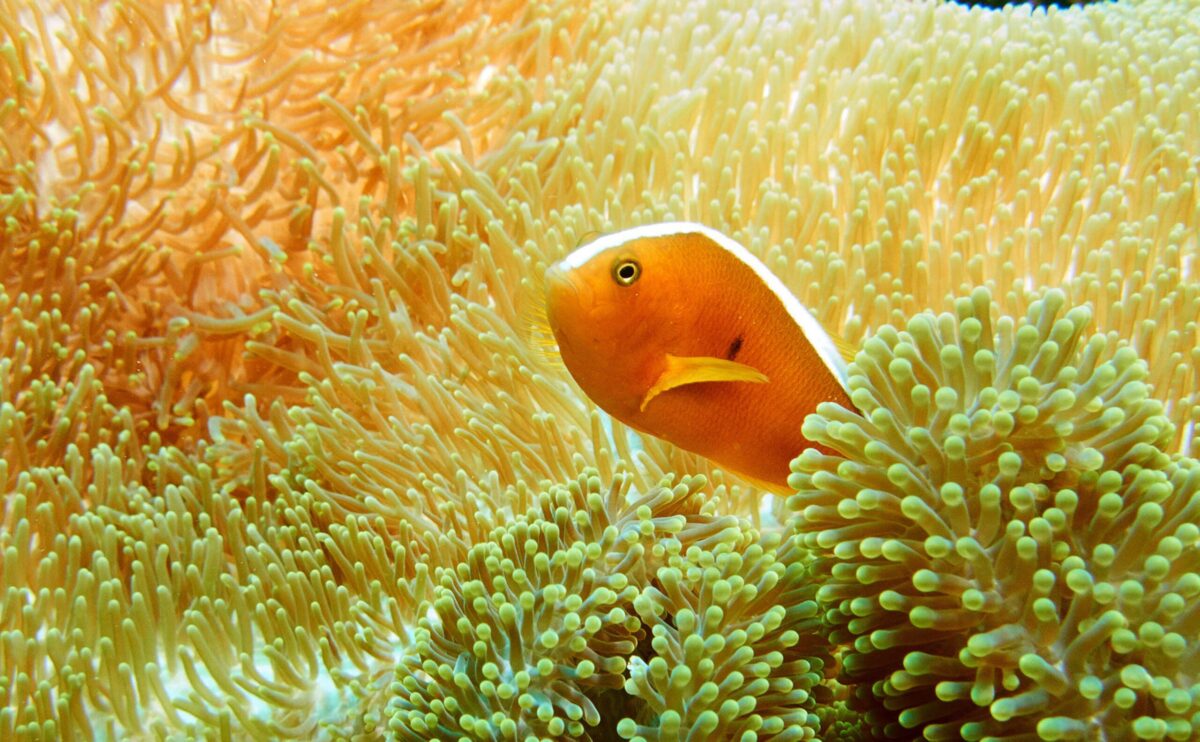
Meet -
Skunk Clownfish
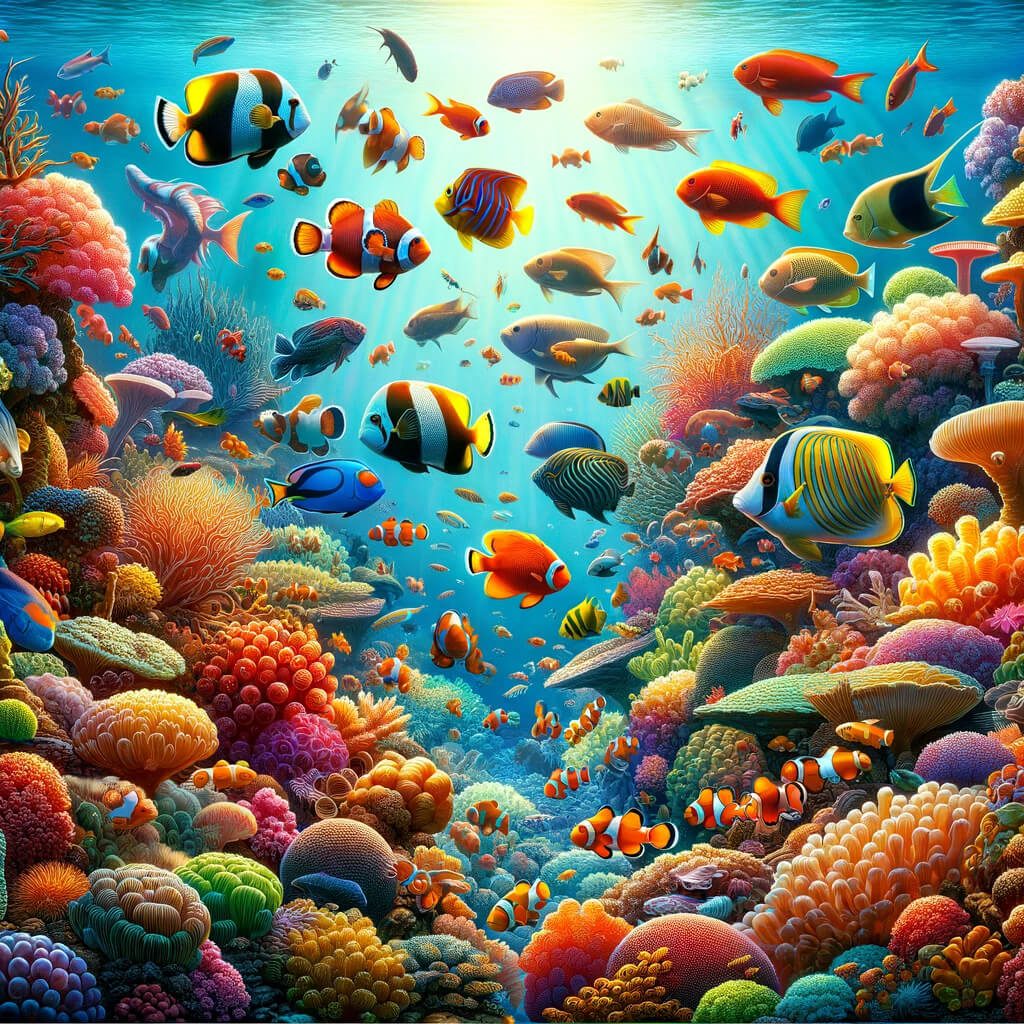
Species Characteristics
Welcome to our comprehensive guide on Amphiprion akallopisos, the Skunk Clownfish. Found in the Indian Ocean, this saltwater aquarium fish is cherished for its striking appearance and fascinating behaviours. In this article, we will explore the world of skunk clownfish, their natural habitat, physical characteristics, aquarium requirements, care, breeding, and more. Whether you are a seasoned marine fish enthusiast or a beginner looking to set up a reef tank, this guide will provide valuable insights and tips for successfully keeping and enjoying Skunk Clownfish in your home aquarium.
Key Takeaways:
- Amphiprion akallopisos, also known as the Skunk Clownfish, is a popular saltwater aquarium fish in the Indian Ocean.
- Skunk Clownfish are characterized by their light orange colouration and a single white stripe from mouth to tail.
- They are reef-associated and commonly found in shallow inshore reefs.
- Skunk Clownfish exhibit fascinating behaviours, including hierarchy establishment and territorial defence using sound.
- Proper care involves providing suitable tank size, maintaining water parameters, and offering a balanced diet.
Table of Contents
Introduction -Skunk Clownfish
Welcome to the fascinating world of the Skunk Clownfish, also known as Amphiprion akallopisos. This section will delve into the taxonomy and classification of this captivating saltwater aquarium fish and explore its natural habitat and distribution.
Taxonomy and Classification
The Skunk Clownfish belongs to the Amphiprion genus and the Pomacentridae family. Its scientific classification is as follows: Domain: Eukaryota, Kingdom: Animalia, Phylum: Chordata, Class: Actinopterygii, Family: Pomacentridae, Genus: Amphiprion, Species: Amphiprion akallopisos.
Natural Habitat and Distribution
The Skunk Clownfish is found in the Indian Ocean, specifically in East Africa, Madagascar, Comoro Islands, Seychelles, Andaman Sea, Sumatra, and the Seribu Islands (Java Sea). These vibrant creatures inhabit shallow inshore reefs with depths ranging from 3 to 25 meters. They thrive in reef-associated environments, including rocky and coral reefs, forming intricate symbiotic relationships with sea anemones. However, it’s worth noting that the Skunk Clownfish is not found in the Maldives and Sri Lanka.
10 Interesting and Unique Facts:
- Named for the distinctive white stripe (“skunk stripe”) that runs along their dorsal ridge.
- Amphiprion akallopisos is found in the Indian Ocean, from the eastern coast of Africa to the Andaman Sea.
- Unlike some clownfish, they typically prefer the upper parts of anemones, which are more exposed.
- Skunk Clownfish have a milder temperament than many of their cousins, making them ideal for peaceful reef tanks.
- They exhibit a mutualistic relationship with their host anemones, gaining protection from predators while providing food scraps for the anemone.
- The Skunk Clownfish’s diet in the wild mainly consists of zooplankton and algae.
- They are known to “dance” with their host anemones, a behaviour thought to strengthen their symbiotic bond.
- Breeding pairs are highly territorial during spawning and will aggressively defend their eggs.
- The “skunk stripe” is a warning sign to potential predators about their symbiotic protection.
- Captive breeding has helped reduce the demand for wild-caught specimens, aiding in conserving natural populations.
Physical Description and Characteristics
Skunk Clownfish, also known as Amphiprion akallopisos, have a unique physical appearance that sets them apart underwater. These captivating saltwater fish feature a light pinkish-orange colour, giving them a vibrant and eye-catching presence in aquariums. One distinguishing characteristic of Skunk Clownfish is the presence of a single, narrow white stripe that runs from their mouth to the back of their tail fin.
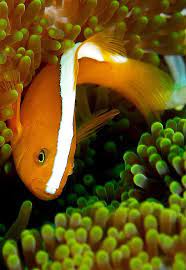
Skunk Clownfish can reach a maximum length of 11 cm, making them a relatively small-sized fish. Despite their compact size, they exhibit remarkable resilience and adaptability.
Colours and Markings
The colouration and markings of Skunk Clownfish are genuinely fascinating. Their bodies display a delicate shade of pinkish orange, which gives them a playful and cheerful appearance. The single white stripe running horizontally across their bodies adds a contrasting touch, highlighting their features and making them easily recognizable.
Gender Differences
Regarding gender differences, Skunk Clownfish do not exhibit any discernible variations in colour patterns between males and females. However, they possess a unique reproductive strategy known as protandrous hermaphroditism. This means that they can change sex during their lifespan. The most prominent individual in a group of Skunk Clownfish will become the dominant female, while the smaller males will develop reproductive organs.
Varieties
Skunk Clownfish have no recognized colour varieties or grades specific to their species. Their natural colouration and markings remain consistent across individuals, maintaining their signature appearance.
Behaviour and Temperament
Skunk Clownfish are known for their peaceful and social behaviour, making them ideal additions to community aquariums. Within their natural habitat, they establish hierarchies within the host anemone they inhabit. The dominant female assumes a leading role, while the smaller males perform essential mating duties.
Skunk Clownfish are generally non-aggressive and have a calm temperament, making them compatible with various tank mates. However, it is essential to research and select appropriate tank mates to ensure a harmonious and balanced aquatic community.
Continue reading to discover the essential aquarium requirements to create a suitable environment for Skunk Clownfish.
Aquarium Requirements
Proper aquarium setup is crucial for the well-being of Skunk Clownfish. In this section, we will discuss the ideal tank size and layout and the necessary water parameters. Additionally, we will explore suitable tank mates, potential conflicts, and the compatibility of Skunk Clownfish with live plants and invertebrates.
Ideal Tank Size and Layout
To ensure the comfort and happiness of Skunk Clownfish, it is recommended to provide them with a tank size of at least 20 gallons. This ensures ample space for swimming and territory establishment. When setting up the tank, it is advised to include live rock structures, anemone replicas, and suitable hiding spots. This mimics their natural habitat and provides them with a sense of security.
Water Parameters
Skunk Clownfish thrive in specific water parameters. They should maintain a temperature range of 24 – 28°C, a pH level of 7.8-8.4, a specific gravity of 1.023-1.025, and ammonia and nitrite levels at 0 ppm. Regular water testing and necessary adjustments are essential for the health and well-being of your Skunk Clownfish.
Suitable Tank Mates and Potential Conflicts
When choosing tank mates for Skunk Clownfish, it is crucial to consider their peaceful and non-aggressive nature. Suitable tank mates include other smaller clownfish, gobies, dottybacks, and some wrasses. However, avoiding keeping them with large and aggressive predators that may harm or stress the Skunk Clownfish is advisable.
Compatibility with Live Plants and Invertebrates
Skunk Clownfish are generally compatible with live plants, but caution should be exercised as they may uproot or damage delicate plant species. If you choose to incorporate live plants in your tank, opt for hardy and robust varieties that can withstand the natural behaviours of Skunk Clownfish. Additionally, Skunk Clownfish are compatible with most invertebrates, including anemones, shrimp, and corals, as long as the overall tank conditions suit the fish and the invertebrates.
Best Anemones to Partner:
- Heteractis magnifica (Ritteri Anemone): Known for its symbiotic relationship with Skunk Clownfish.
- Entacmaea quadricolor (Bubble Tip Anemone): Popular for its ease of care and compatibility with Skunk Clownfish.
Skunk Clownfish – Care
Proper care is essential to ensure the health and well-being of Skunk Clownfish in a saltwater aquarium. Following the necessary guidelines can create an optimal environment for these captivating fish.
5 Tips on Care
Tank Flow: Skunk Clownfish prefer moderate water flow miming their natural reef environment.
Social Structure: They’re less aggressive than other clownfish species, making them suitable for community tanks with careful selection.
Hideouts: Incorporate live rock with ample hiding places to provide security.
Diet Variation: Supplement their diet with foods rich in carotenoids to maintain their vibrant colouration.
Observation: Regularly check for signs of stress or disease, as Skunk Clownfish may hide symptoms until they’re severe.
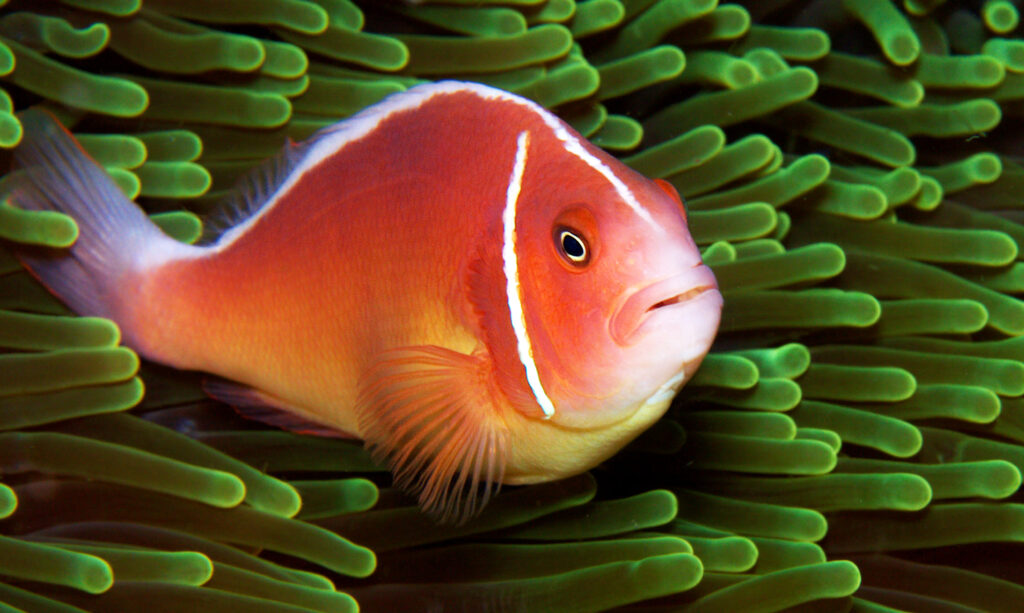
Diseases
Skunk Clownfish are susceptible to various diseases common among saltwater fish. It is essential to be aware of these diseases and take preventive measures to maintain their health.
- White Spot Disease (Ich): This parasitic infection appears as white spots resembling grains of salt on the fish’s body. Prompt treatment with a suitable medication is necessary to prevent the spread of the disease.
- Marine Velvet: Also known as Amyloodinium, this microscopic parasite causes Velvet Disease. It can result in loss of appetite, lethargy, and skin discolouration. Ensure proper quarantine procedures and treat affected fish promptly.
- Bacterial Infections: Bacterial infections can lead to symptoms such as fin rot, popeye, or ulcers. Maintain good water quality, provide a stress-free environment, and consider adding a UV sterilizer to reduce the risk of bacterial infections.
Observing the fish’s behaviour and appearance regularly is essential to preventing disease outbreaks. If any signs of illness are detected, swift action should be taken for appropriate treatment.
Common Health Issues in Skunk Clownfish
Skunk Clownfish can experience various health issues that may affect their overall well-being. Some common health issues to watch out for include:
- Fin damage or injuries caused by aggressive tank mates or sharp decor.
- Stress-related issues due to improper tank conditions, sudden changes in water parameters, or excessive handling.
- Internal or external parasites can cause discomfort and affect the fish’s health. Regular observation and treatment are crucial in preventing parasite infestations.
Skunk Clownfish Disease Prevention
Prevention is the key to maintaining the health of Skunk Clownfish. Here are some essential tips to prevent diseases and promote their well-being:
- Provide a well-maintained saltwater aquarium with proper filtration to remove waste and maintain water quality.
- Regularly test water parameters and perform partial water changes to ensure optimal conditions.
- Practice good aquarium hygiene, including cleaning decorations, removing uneaten food, and maintaining a clean substrate.
- Introduce new fish and coral specimens after proper quarantine procedures to prevent the introduction of diseases to the tank.
- Ensure a stress-free environment by maintaining stable water conditions, minimizing disturbances, and offering suitable hiding places.
- Provide an appropriately sized and well-functioning protein skimmer to enhance water quality and reduce the risk of disease outbreaks.
By implementing these disease prevention measures, you can help keep your Skunk Clownfish healthy and vibrant, allowing them to thrive in their saltwater aquarium.
Diet and Feeding
Proper diet and feeding habits are crucial for maintaining the health and vitality of Skunk Clownfish. Understanding their dietary preferences and providing a balanced and nutritious diet is essential for their well-being.
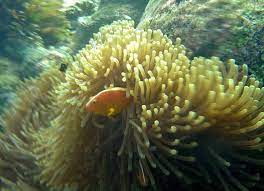
Skunk Clownfish are naturally omnivorous, which means they consume animal and plant-based food sources. In their natural habitat, their diet consists of tiny zooplankton, copepods, tunicate larvae, and algae. In a captive environment, it is essential to replicate their natural diet as closely as possible.
Dietary Preferences
Skunk Clownfish have specific dietary preferences that should be considered when feeding them. They thrive on various foods, including commercial pellets and flake foods for marine fish. These foods are formulated to provide essential nutrients and vitamins necessary for their growth and development.
Recommended Foods and Feeding Schedule
Alongside commercial foods, Skunk Clownfish can also be fed frozen or live foods such as brine shrimp, mysis shrimp, and chopped seafood. These protein-rich foods mimic their natural diet and provide them with the necessary nutrients for a healthy and balanced lifestyle.
To ensure optimal nutrition and health, it is recommended that Skunk Clownfish be fed small meals multiple times a day. This feeding schedule resembles their natural feeding patterns, where they forage for food throughout the day.
Tips on Ensuring a Balanced and Nutritious Diet
Here are some tips to ensure a balanced and nutritious diet for your Skunk Clownfish:
- Supplement their diet with high-quality marine fish vitamins to enhance their immune system and overall health.
- Consider offering algae-based foods to cater to their herbivorous needs. These can include seaweed sheets or algae pellets.
- Observe their feeding behaviour and adjust the quantity of food accordingly. Avoid overfeeding, which can lead to health issues and poor water quality.
- Vary their diet by incorporating different types of dry and frozen foods to provide a wide range of nutrients and prevent boredom.
By following these tips and understanding their dietary preferences, you can ensure your Skunk Clownfish receive a balanced and nutritious diet, promoting their overall health and longevity.
Breeding and Reproduction
Skunk Clownfish are fascinating creatures when it comes to breeding and reproduction. Let’s explore the different aspects of this process.
5 Unique Breeding Tips
Pair Bonding: Introduce potential pairs early, as Skunk Clownfish form strong monogamous bonds.
Spawning Environment: Ensure the breeding tank has subdued lighting and a flat surface for egg-laying near the anemone.
Egg Care: Gently aerate the water near the eggs to mimic the male’s fanning behaviour in the wild.
Post-Hatch Care: Feed the fry with rotifers, gradually introducing more significant foods like baby brine shrimp.
Record Keeping: Maintain detailed notes on breeding attempts, egg counts, and fry survival rates for improvement over time.
Sexing
Sexing Skunk Clownfish can be challenging since there are no external physical differences between males and females. However, there is a unique aspect to their reproductive behaviour. The largest individual in a group will become female, while the smaller individuals will remain male. This phenomenon is known as protandrous hermaphroditism.
Breeding Behavior and Conditions
When it comes to breeding, Skunk Clownfish exhibit interesting courtship behaviours. The male initiates the process by displaying courtship behaviours such as chasing the female and cleaning a nest site. A suitable host anemone and ample hiding spaces in the tank are crucial for successful reproduction.
Care of Eggs and Fry
Once the female lays her eggs, the male fertilizes them and is responsible for guarding them. This behaviour ensures the safety and development of the eggs until they hatch. Caring for the eggs and fry involves maintaining optimal water quality, providing appropriate food, and protecting them from potential threats in the tank.
Challenges in Breeding in Captivity
Breeding Skunk Clownfish in captivity can be challenging due to their specific environmental and behavioural requirements. Finding compatible pairs is essential, and proper breeding conditions must be met. Overcoming these challenges requires careful attention and expertise to provide the conditions for successful breeding.
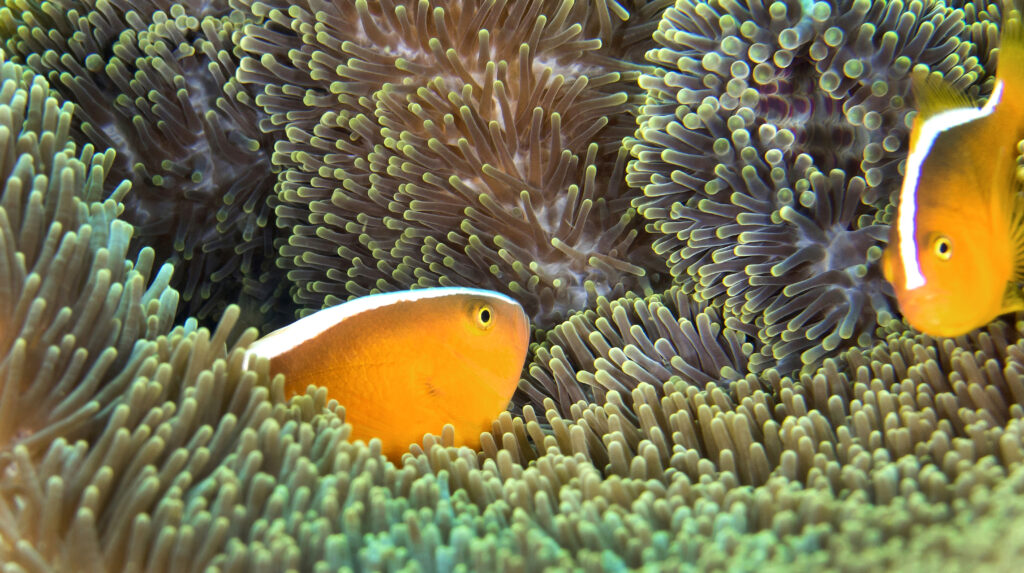
Skunk Clownfish breeding and reproduction are fascinating processes that require careful observation and attention to detail. By understanding the sexing, breeding behaviour, and proper care of eggs and fry, passionate aquarists can take on the rewarding challenge of breeding these beautiful creatures in captivity.
Summary
The Amphiprion akallopisos, or Skunk Clownfish, is a captivating and popular saltwater aquarium fish. With its light orange colouration and distinctive white stripe, it adds beauty and entertainment to any marine aquarium.
Skunk Clownfish, native to the Indian Ocean, are typically found in shallow inshore reefs. They display fascinating behaviours, such as establishing hierarchies and defending their territories using sound.
To ensure the well-being of Skunk Clownfish, it is essential to meet their specific care requirements. These include providing a suitable tank size, maintaining proper water parameters, and choosing compatible tank mates. Skunk Clownfish are omnivorous and require a balanced diet of commercial foods and live or frozen options.
Breeding Skunk Clownfish can be both challenging and rewarding. Careful attention to breeding conditions and fry care is necessary to successfully raise a new generation of these unique fish.
In summary, the Skunk Clownfish, or Amphiprion akallopisos, is an enchanting marine species that brings joy and aesthetic appeal to saltwater aquariums. From their striking appearance to their intriguing behaviours, these fish offer a captivating experience for enthusiasts. By meeting their specific care requirements and providing a healthy environment, Skunk Clownfish can thrive and become a beloved addition to any marine aquarium.
Source Links
FAQ's
What is the taxonomy and classification of the Skunk Clownfish?
The Skunk Clownfish belongs to the family Pomacentridae, genus Amphiprion, and species Amphiprion akallopisos.
Where is the natural habitat of the Skunk Clownfish?
Skunk Clownfish are found in the Indian Ocean, specifically in East Africa, Madagascar, Comoro Islands, Seychelles, Andaman Sea, Sumatra, and the Seribu Islands (Java Sea).
What are the colors and markings of the Skunk Clownfish?
Skunk Clownfish have a distinct light pinkish orange coloration with a single, narrow white stripe running from their mouth to the back of the tail fin.
Are there any gender differences in Skunk Clownfish?
There are no significant differences in color patterns between males and females.
What are the ideal tank size and layout for Skunk Clownfish?
Skunk Clownfish require a tank with a minimum capacity of 20 gallons to provide ample space for swimming and territory establishment. It is recommended to set up the tank with live rock structures, anemone replicas, and suitable hiding spots to mimic their natural habitat.
What are the water parameters for Skunk Clownfish?
The water parameters for Skunk Clownfish should be maintained at a temperature range of 25.6 - 29.3°C, pH level of 8.1-8.4, specific gravity of 1.023-1.025, and ammonia and nitrite levels of 0 ppm.
What are suitable tank mates for Skunk Clownfish?
Suitable tank mates for Skunk Clownfish include peaceful and non-aggressive species such as other smaller clownfish, gobies, dottybacks, and some wrasses. It is important to avoid keeping them with large and aggressive predators.
Are Skunk Clownfish compatible with live plants and invertebrates?
Skunk Clownfish are generally compatible with live plants, but caution should be taken as they may uproot or damage delicate plant species. They are compatible with most invertebrates, including anemones, shrimp, and corals, as long as the overall tank conditions are suitable.
What diseases are Skunk Clownfish susceptible to?
Skunk Clownfish are susceptible to common saltwater fish diseases, such as white spot disease (Ich), marine velvet, and bacterial infections. Regular observation and prompt treatment are crucial in preventing and managing these diseases.
What should be included in the diet of Skunk Clownfish?
Skunk Clownfish are omnivorous and have a natural diet that consists of small zooplankton, copepods, tunicate larvae, and algae. In captivity, they can be fed a variety of commercial pellet and flake foods designed for marine fish, as well as frozen or live foods such as brine shrimp, mysis shrimp, and chopped seafood.
How do you sex Skunk Clownfish?
Sexing Skunk Clownfish can be challenging, as there are no external physical differences between males and females. The largest individual in a group will become the female, while smaller individuals will remain males.
What are the challenges in breeding Skunk Clownfish in captivity?
Breeding Skunk Clownfish in captivity can be challenging due to specific environmental and behavioral requirements, as well as the need for compatible pairs.
